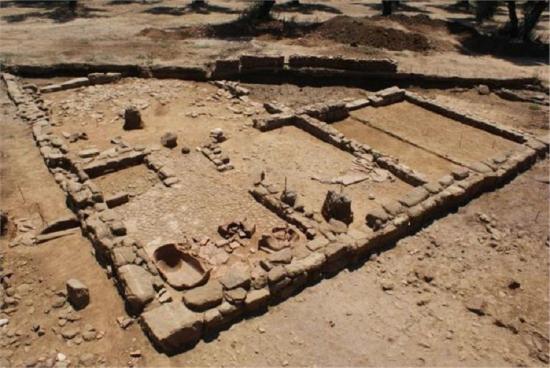ANA-MPA
Source -http://archaeologynewsnetwork.blogspot.co.uk/2014/10/more-on-ancient-city-found-in-western.html#.VFAUpTSG_qQ
An extensive part of the later classical-Hellenistic city of Alikyrnas near Mesologgi came to light during the construction of the freeway 'Ionia Odos'.

Remains of a private house at Alikyrnas [Credit: Greek Ministry of Culture]
The city is known from ancient sources (Strabo, Pliny), which place it between the two major cities of Kalydona and Plevronas, near the modern village of Ag. Thomas of Mesolonghi, on a hillock called 'thousand houses'. At the northernmost tip of the hill are the ruins of a small fortification wall enclosing the acropolis of about five acres in area. However, building remains of the city had not been investigated until now. The axis of the Ionian highway cuts through the heart of the ancient city for about 400 metres and the entire site spans a total area of 20 acres. The excavations began in 2011 and are now nearing completion, having brought to light part of the commercial centre and the surrounding residential areas.

General view of the excavation of Alikyrnas [Credit: Greek Ministry of Culture]
The city seems to have been originally organized according to the Hippodamian orthogonal urban layout, as attested by four roads running in a northeastern direction at 32 metre intervals, each of which is 4.5 metres wide. A wider road, some 5.2 metres in width, appears to have been the main street that ran through the city in an east-west direction. The streets are defined by retaining walls made from local sandstone, between 60 and 80 centimetres in thickness.

Finds from the Hellenistic city Alikyrnas near Mesologgi [Credit: Greek Ministry of Culture]
So far archaeologists have identified 10 urban areas, most of which have been identified as commercial in nature (warehouses, workshops, stores). The western boundary of the city seems to have been the natural embankment of the St. Simeon riverbed, on the banks of which were discovered a large deposit of pottery and figurines, probably from a sanctuary whose location has not yet been identified. Finally, at the southernmost tip of the Hellenistic citadel, archaeologists found evidence of proto-Geometric installations.